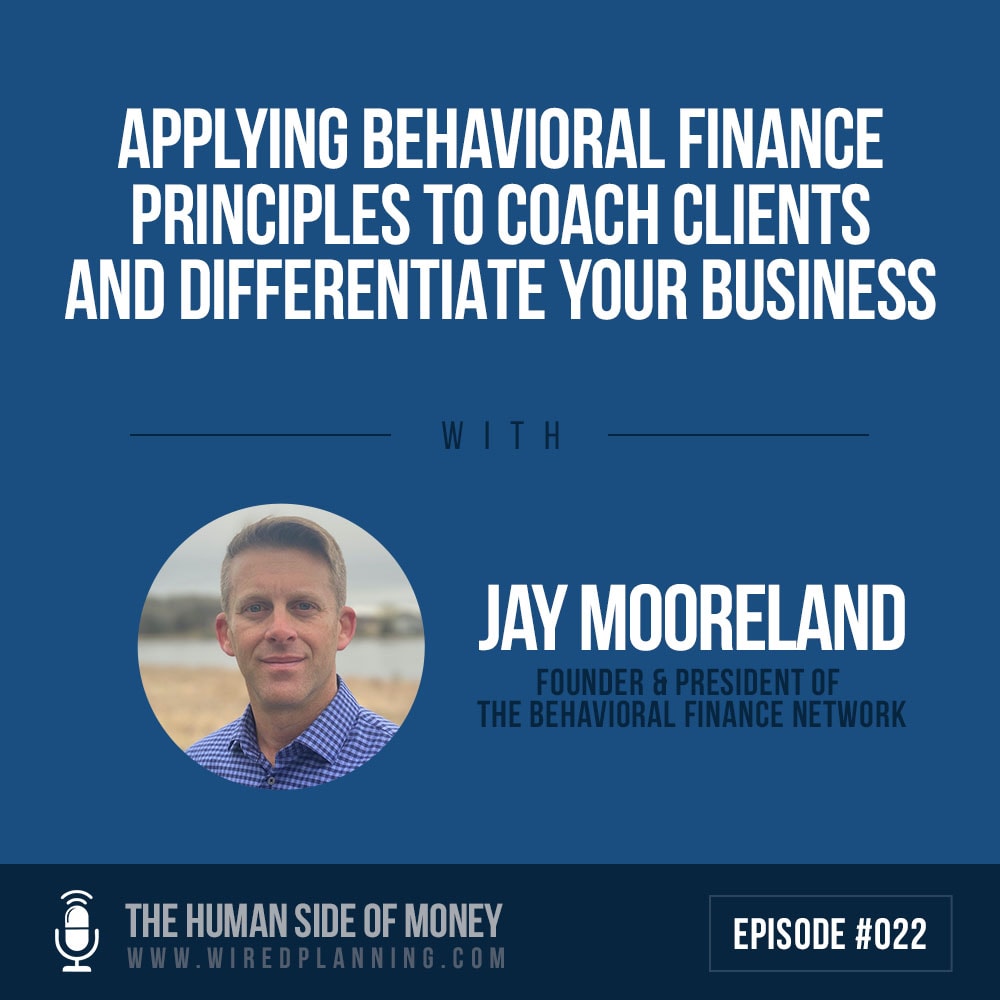Show Links
*If you want to be notified when the next episode packed full of practical tips and strategies to master the human side of money will be released, you can:
- Subscribe to the Show
- Join the community of like-minded advisors and planners across the world being notified via email. In addition to podcast releases, you’ll get our monthly “Wisdom Round Up” where we deliver to you the best content from around the industry on applying behavioral finance and mastering the human side of money.
Episode Summary
Ask any financial advisor whether they think it’s important to understand and apply behavioral finance into their work with clients, and you’ll get a resounding “Yes.”
Ask those same financial advisors to identify the biggest barrier preventing them from doing it more often and more effectively, and the response will be unanimous:
There is a lack of quality training and resources on practical ideas and strategies that show exactly how to do it.
Academic research has done an outstanding job advancing the field of behavioral finance, particularly with a focus on how individuals behave. We’ve even seen strides in going from how individuals behave to why individuals behave a certain way and the biases at play that explain the how.
But, the biggest gap yet to be bridged is between why and what. In other words, knowing why someone behaved in a certain why doesn’t help you know what can be done to improve the behavior. And, the what is ultimately where true behavior change occurs.
For example, take the classic example of a 60-year old woman with her retirement assets invested in the market. In March of 2020, when the market plummeted close to 35% in one month, she sold out of the market entirely. We know how she behaved (sold out). We know why she behaved that way (she was suffering from loss-aversion, recency bias, availability bias, etc.). But none of that matters unless you know what to do about it.
What can you do to help her overcome the biases she’s experiencing to change her behavior for the better? That’s where the application of behavioral finance comes into play. It’s the what.
At the same time, behavioral finance has developed a reputation as being synonymous with keeping clients invested in the market. The reality is that it extends far beyond that simple application.
In fact, when applied effectively (as opposed to trying a few tactics you heard in a webinar), the application of behavioral finance should allow you to:
- Coach your clients to better outcomes
- Differentiate yourself from all forms of competition
But, again, there’s a wide gap between recognizing the person you’re talking to is dealing with overconfidence and actually knowing what to say, how to say it, when to say it, and what to do on the path to removing the bias from decision-making.
That’s effective behavioral finance in action. And that’s what will allow you to deliver better outcomes for clients while differentiating your business.
Things You’ll Learn
- How to implement a “Behavioral Plan Policy Statement” with clients to pre-commit to desired actions while in a rational state of mind
- What effective behavioral coaching looks like and where most advisors get it wrong
- How proactive communication instills good behavior and the different ways to use it with clients
- How effectively applying behavioral finance principles serves as a way to differentiate your business
- Why you should be sure to coach on a principle in every meeting
- The role of questions on behavior and his favorite question to ask prospective clients
- Jay’s communication strategy to keep client’s from ever reaching the edge instead of talking them off of it
About Jay Mooreland
Jay Mooreland is a behavioral finance coach that helps advisors and planners grow their business by incorporating psychological principles. He created The Emotional Investor blog to help advisors better understand the biases their clients fall prey to in order to improve outcomes in the future. He also founded The Behavioral Finance Network, where he works with advisors directly to apply psychological principles in their business.
And, in addition to speaking at conferences around the world on investor behavior, he wrote an Amazon best-selling book on the topic called The Emotional Investor: How Biases Influence Your Investment Decisions…And What You Can Do About It.
Other Episodes You’ll Like On Apply Behavioral Finance
- Episode 5: Managing Humans Instead of Assets to Deliver Better Outcomes with Andy Hart
- Episode 6: Bringing Behavior to Life in Financial Planning with Neil Bage
- Episode 8: The Path to Building a “Behavioralized” Practice with Daniel Crosby
Resources
- The Behavioral Finance Network
- The Behavioral Finance Network Membership Page
- The Emotional Investor Blog
- The Emotional Investor: How Biases Influence Your Investment Decisions….And What You Can Do About It by Jay Mooreland
- Jay Mooreland LinkedIn
- Predictably Irrational: The Hidden Forces That Shape Our Decisions by Dan Ariely
- Vanguard’s Advisor Alpha
- Ben Carlson
- Morgan Housel
- Daniel Crosby
- Your Money and Your Brain: How The New Science of Neuroeconomics Can Help Make You Rich by Jason Zweig
Whenever you’re ready, there are 3 ways I can help you master the human side of advice:
- HSOA Masterclass: An 8-week group program on building trust & connection, aligning money and life, and delivering frictionless advice.
- The Ultimate Discovery Meeting: A proven framework to seamlessly convert prospects into life-long clients in one meeting.
- HSOA Community (COMING SOON!): An online space to meet, collaborate, discuss, brainstorm, learn and grow with other advisors passionate about the human side of advice
If you’re interested, let me know here.

